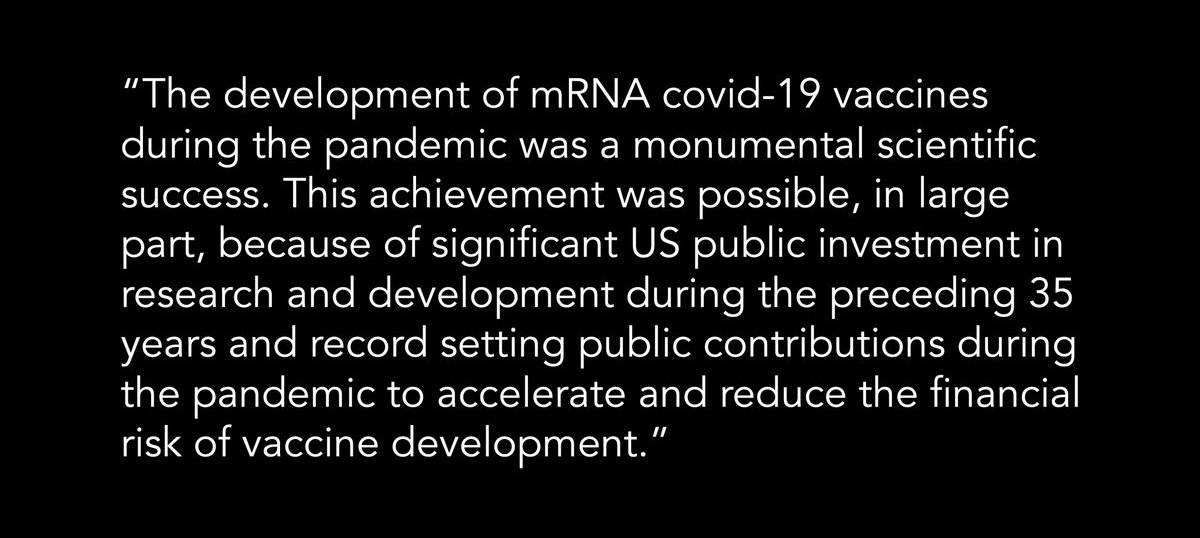Editorials
Financing covid-19 mRNA vaccines
BMJ 2023; 380 doi: https://doi.org/10.1136/bmj.p413 (Published 01 March 2023)Cite this as: BMJ 2023;380:p413
FOR EDUCATIONAL PURPOSES
Public risk taking, private rewards
Since the launch of their covid-19 vaccines, Moderna and Pfizer have accumulated more than $100bn (£83; €94) in global revenues from sales—more than 20 times the World Health Organization’s biennial budget in 2020-21.123Yet for a vaccine that is estimated to cost $1-3 per dose to manufacture, both Moderna and Pfizer have announced plans to charge more than $110 a dose in the US this year—a price that Moderna’s CEO Stéphan Bancel has argued is “consistent with the value” of these vaccines.4
Victor Roy, physician fellow
But value for whom?
In making health and protection possible amid a deadly pandemic, the mRNA covid-19 vaccines have been a remarkable achievement. However, their development also serves as a cautionary tale of a system in which the risks of pursuing innovation were socialized, while the lion’s share of rewards became privatized to corporate shareholders—financial actors who risked little of their capital in the development process.5
Driven by their vaccine sales, Moderna and Pfizer together report a combined $53bn in cash on hand.12Exemplifying patterns from across the sector, the companies are targeting their capital in two primary directions: acquisitions and shareholder payouts.6 Acquiring smaller companies with lucrative patents delivers the scale and speed of growth that Wall Street expects; and rather than reinvest in their business, companies use one form of shareholder payouts, share buybacks, to buy their own stocks in a bid to boost their share price. Moderna has already announced or executed $7bn in share buybacks between 2021 and 2022, $3bn more than the company spent on research and development in that time.1 In the decade before the pandemic, Pfizer spent $115bn in payouts to shareholders, $34bn more than it spent on research and development.7 This pattern of value extraction has escalated across the economy, all in the name of “maximizing shareholder value.”
Lalani and colleagues’ linked study (doi:10.1136/bmj-2022-073747) of the public investment behind mRNA covid-19 vaccines documents a strikingly different account of value: one of government led value creation.8 Firstly, they found that the US government was a risk taking technology investor and developer. It provided at least $337m in long term capital that produced four technologies underpinning the mRNA vaccines, as well as $1.8bn for Moderna’s clinical trials. Secondly, government buyers created the global market for covid-19 vaccines through advanced purchasing agreements, with the US government guaranteeing $29.2bn for 2 billion doses. Overall, Lalani and colleagues estimated that the US government invested $31.9bn to develop, produce, and purchase covid-19 vaccines through March 2022. This figure is likely a substantial underestimate given the authors’ conservative classification of public funding for pre-pandemic research; they cite an additional $5.9bn in indirectly related US public financing.
Traditional policy thinking narrowly conceives of the public role in biomedical research as “fixing market failures” by financing basic science.9 Yet the covid-19 mRNA vaccines show that public risk taking and investment were essential in shaping all stages of technology development, production, and procurement. The US government failed to take on one other important role, however: directing the very value it played an indispensable role in creating. An alternate innovation strategy would instead include three features: directionality, conditionality, and public options.
Firstly, innovation has not just a rate but a direction—in this case, toward achieving the public health goal of widespread vaccination. Imagine if, instead of Operation Warp Speed, the US government had pursued Operation Global Vaccination? By contrast to the sharp inequities in global access that ensued, this clear goal could have guided ex-ante decisions about governing intellectual property and technology transfer that could have accelerated worldwide vaccine coverage and saved lives.10
Secondly, to achieve public goals, the US government can use its position as a pivotal investor and buyer to set conditions in contracts.11 These conditions would relate to pricing and access, technology transfer, and reinvestment in innovation. The UK government, for example, negotiated pricing and access provisions with Astra-Zeneca during development of its covid-19 vaccine.12 The Bush administration created a program to transfer technology and scale-up for influenza vaccine manufacturing around the world in the mid-2000s.10 And for companies receiving government pandemic aid, US officials prohibited share buybacks and considered taking equity stakes to encourage reinvestment and a fairer return on public investment.1314
Thirdly, governments should explore building public options to manufacture critical health technologies. In addition to securing supply in public health emergencies, public production has two other benefits. Revenues can be reinvested into domestic innovation and manufacturing; and a public option serves as negotiating leverage for fairer deals with private manufacturers. Old and fresh experiments in public production of pharmaceuticals can provide a basis for scaling up public options.1516
Instead of maximizing value for corporate shareholders, these alternatives would enable governments to translate public investments more fully in the service of public health—a fundamental priority as we examine our response to this pandemic and prepare for the next.
Acknowledgments
The author of this publication is a Veterans Affairs Scholar through the Yale National Clinician Scholars Program. Its contents are solely the responsibility of the author and do not represent the official view of the Department of Veterans Affairs.
Footnotes
-
Competing interests: The BMJ has judged that there are no disqualifying financial ties to commercial companies. The author declares the following other interests: none. Further details of The BMJ policy on financial interests is here: https://www.bmj.com/sites/default/files/attachments/resources/2016/03/16-current-bmj-education-coi-form.pdf.”
-
Provenance: Commissioned; not externally peer reviewed.
This article is made freely available for personal use in accordance with BMJ’s website terms and conditions for the duration of the covid-19 pandemic or until otherwise determined by BMJ. You may download and print the article for any lawful, non-commercial purpose (including text and data mining) provided that all copyright notices and trade marks are retained.
References

